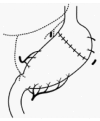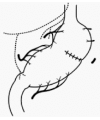Function-preserving gastrectomy for gastric cancer in Japan
- PMID: 27468183
- PMCID: PMC4948261
- DOI: 10.3748/wjg.v22.i26.5888
Function-preserving gastrectomy for gastric cancer in Japan
Abstract
Surgery used to be the only therapy for gastric cancer, and since its ability to cure gastric cancer was the focus of attention, less attention was paid to function-preserving surgery in gastric cancer, though it was studied for gastroduodenal ulcer. Maki et al developed pylorus-preserving gastrectomy for gastric ulcer in 1967. At the same time, the definition of early gastric cancer (EGC) was being considered, histopathological investigations of EGC were carried out, and the validity of modified surgery was sustained. After the development of H2-blockers, the number of operations for gastroduodenal ulcers decreased, and the number of EGC patients increased simultaneously. As a result, the indications for pylorus-preserving gastrectomy for EGC in the middle third of the stomach extended, and various alterations were added. Since then, many kinds of function-preserving gastrectomies have been performed and studied in other fields of gastric cancer, and proximal gastrectomy, jejunal pouch interposition, segmental gastrectomy, and local resection have been performed. On the other hand, from the overall perspective, it can be said that endoscopic resection, which was launched at almost the same time, is the ultimate function-preserving surgery under the current circumstances. The current function-preserving gastrectomies that are often performed and studied are pylorus-preserving gastrectomy and proximal gastrectomy. The reasons for this are that these procedures that can be performed with systemic lymph node dissection, and they include three important elements: (1) reduction of the extent of gastrectomy; (2) preservation of the pylorus; and (3) preservation of the vagal nerve. In addition, these operations are more likely to be performed with a laparoscopic approach as minimally invasive surgery. Of the above-mentioned three elements, reduction of the extent of gastrectomy is the most important in our view. Therefore, we should try to reduce the extent of gastrectomy if curability of the gastric cancer can still be achieved. However, if we preserve a wider residual stomach in function-preserving gastrectomy, we should pay attention to the development of metachronous gastric cancer.
Keywords: Early gastric cancer; Function-preserving gastrectomy; Laparoscopic surgery; Quality of life.
Figures






Similar articles
-
Novel operative technique for vagal nerve- and pyloric sphincter-preserving distal gastrectomy reconstructed by interposition of a 5 cm jejunal J pouch with a 3 cm jejunal conduit for early gastric cancer and postoperative quality of life 5 years after operation.World J Surg. 2004 Aug;28(8):766-74. doi: 10.1007/s00268-004-6987-2. Epub 2004 Aug 3. World J Surg. 2004. PMID: 15457356
-
[Function-preserving gastrectomy for early gastric cancer based on Japanese researches].Zhonghua Wei Chang Wai Ke Za Zhi. 2018 Feb 25;21(2):148-153. Zhonghua Wei Chang Wai Ke Za Zhi. 2018. PMID: 29492912 Chinese.
-
[Function preserving gastrectomy].Zhonghua Wei Chang Wai Ke Za Zhi. 2016 Feb;19(2):233-7. Zhonghua Wei Chang Wai Ke Za Zhi. 2016. PMID: 26831890 Chinese.
-
Function-preserving gastrectomy for early gastric cancer.Ann Surg Oncol. 2013 Aug;20(8):2683-92. doi: 10.1245/s10434-013-2931-8. Epub 2013 Mar 16. Ann Surg Oncol. 2013. PMID: 23504120 Review.
-
[Pylorus-preserving gastrectomy for early gastric cancer].Nihon Geka Gakkai Zasshi. 1996 Apr;97(4):291-6. Nihon Geka Gakkai Zasshi. 1996. PMID: 8692146 Review. Japanese.
Cited by
-
Current status of proximal gastrectomy for gastric and esophagogastric junctional cancer: A review.Ann Gastroenterol Surg. 2020 Jun 21;4(5):498-504. doi: 10.1002/ags3.12365. eCollection 2020 Sep. Ann Gastroenterol Surg. 2020. PMID: 33005844 Free PMC article. Review.
-
Feasibility of totally laparoscopic pylorus-preserving gastrectomy with intracorporeal gastro-gastrostomy for early gastric cancer: a retrospective cohort study.World J Surg Oncol. 2020 Jul 16;18(1):170. doi: 10.1186/s12957-020-01955-z. World J Surg Oncol. 2020. PMID: 32677964 Free PMC article.
-
Advances in the surgical management of gastric and gastroesophageal junction cancer.Transl Gastroenterol Hepatol. 2021 Jan 5;6:16. doi: 10.21037/tgh.2020.02.06. eCollection 2021. Transl Gastroenterol Hepatol. 2021. PMID: 33409410 Free PMC article. Review.
-
Intraoperative Tumor Localization of Early Gastric Cancers.J Gastric Cancer. 2021 Mar;21(1):4-15. doi: 10.5230/jgc.2021.21.e4. Epub 2021 Mar 23. J Gastric Cancer. 2021. PMID: 33854809 Free PMC article. Review.
-
Body image and quality of life undergoing totally robotic versus robotic-assisted distal gastrectomy: a retrospective propensity score matched cohort study.BMC Surg. 2024 Oct 9;24(1):295. doi: 10.1186/s12893-024-02597-8. BMC Surg. 2024. PMID: 39385219 Free PMC article.
References
-
- Japanese Gastric Cancer Association. Japanese gastric cancer treatment guidelines 2010 (ver. 3) Gastric Cancer. 2011;14:113–123. - PubMed
-
- Katai H, Sasako M, Fukuda H, Nakamura K, Hiki N, Saka M, Yamaue H, Yoshikawa T, Kojima K. Safety and feasibility of laparoscopy-assisted distal gastrectomy with suprapancreatic nodal dissection for clinical stage I gastric cancer: a multicenter phase II trial (JCOG 0703) Gastric Cancer. 2010;13:238–244. - PubMed
-
- Lee SW, Nomura E, Bouras G, Tokuhara T, Tsunemi S, Tanigawa N. Long-term oncologic outcomes from laparoscopic gastrectomy for gastric cancer: a single-center experience of 601 consecutive resections. J Am Coll Surg. 2010;211:33–40. - PubMed
-
- Hioki K, Nakane Y, Yamamoto M. Surgical strategy for early gastric cancer. Br J Surg. 1990;77:1330–1334. - PubMed
-
- Sawai K, Takahashi T, Suzuki H. New trends in surgery for gastric cancer in Japan. J Surg Oncol. 1994;56:221–226. - PubMed
Publication types
MeSH terms
LinkOut - more resources
Full Text Sources
Other Literature Sources
Medical
Research Materials

